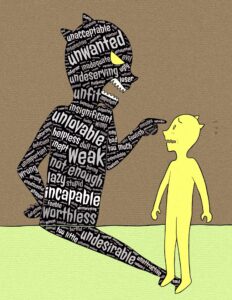Facing your Inner Saboteur When it comes to assessments of...
Read More
Series – Reduce your stressors and achieve peak performance : Part 3/6 – Emotional Influencers

As leaders, we have seen it all: tantrums, waterworks, shouting matches, and other emotional breakdowns by employees. As leaders, we may have caused or contributed to some of these highly charged scenarios. These are examples of emotions getting out of control at work and being expressed in self-sabotaging and unprofessional ways.
Currently, there is judgment about emotions in the workplace and the prominence of black-and-white thinking about “good emotions,” e.g., celebrations after winning a contract, vs. “bad emotions,” e.g., jealousy over the promotion of a peer. I used to hold some of these limiting beliefs myself, when as a female executive, I wouldn’t allow myself to openly display fear, anger, guilt, or sadness, thinking that it would be a sign of weakness.
I wish I had known then what I know now. All feelings are valid and serve a purpose. To express ourselves as authentic leaders, we don’t need to hide our emotions as long as we convey them appropriately and professionally. This does require practice. But, once we master our own emotions and learn how to guide our team members in managing their emotions, we hold the key to building high-performance teams.
This article is the third in a series that I created to help you optimize your environment, achieve a higher quality of life, and reach peak performance. The Institute of Professional Excellence in Coaching (iPEC) identified six major stressors, a.k.a. influencers, that can rob us of energy:
- Spiritual
- Mental
- Emotional
- Physical
- Social
- Environmental
Suppose you can embrace the thought that emotions are neither good nor bad but simply indicators to notice and act on. In that case, you are already ahead in managing your emotions at work and in life productively. There are many models categorizing emotions. IPEC utilizes the FLAG acronym to identify five core emotions:
Fear – born out of self-protection to lose something that is of value to you
Love – the most powerful emotion and everyone’s most significant driving force
Anger – a reaction to feeling threatened
Guilt – when who you are is not being honored by what you do or say
Sadness and grief – the loss of a person or hope or dream
Once you can name your emotion, you can determine what may have triggered it. For example, a less-than-stellar performance review may have triggered feelings of anger towards your manager and fear of losing your job, or your buttons may have been pushed because someone said something about you that hurt your innermost feelings. I have published articles in the past about triggers and how to respond rather than react. Check out the following:
https://belladonnacareercoach.com/stop-pushing-my-buttons/
https://belladonnacareercoach.com/the-day-i-lost-my-sht-at-work/
If you are easily triggered and are concerned you might be self-sabotaging your career because you react to emotional stressors and take them personally, I recommend you work with me as your coach. Together, we can increase your level of awareness so that you break the reactive pattern and choose how to respond rather than react. Contact me at angela@belladonnacareercoach.com.
A Common Struggle for Women in the Workplace – Setting Boundaries
A Common Struggle for Women in the Workplace – Setting...
Read MoreSeries – Utilizing Coaching Skills to Become a Better Leader – Part 8 Brainstorming
Series – Utilizing Coaching Skills to Become a Better Leader...
Read More


